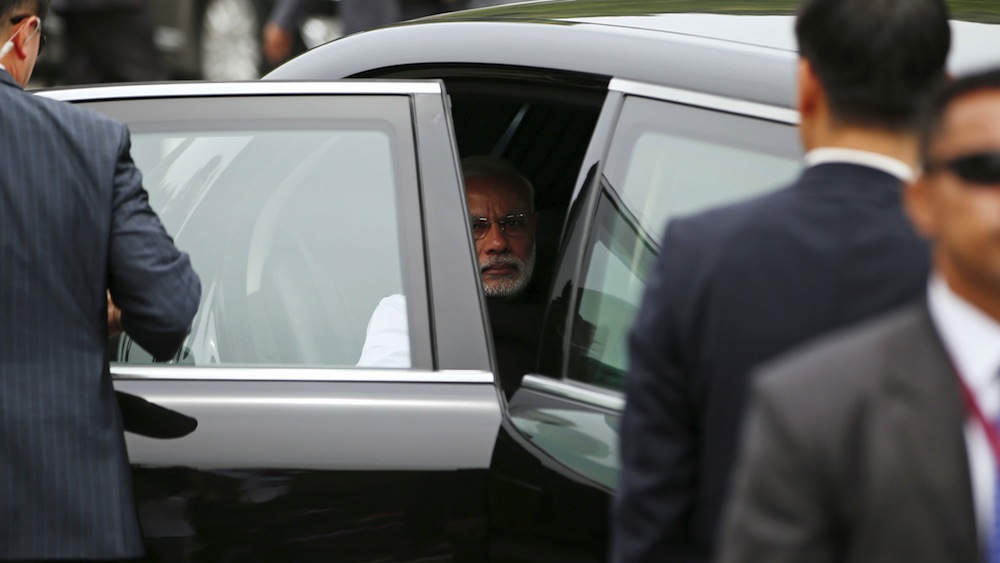The European Union and India have quite a bit to offer one another; the former possesses the technological framework for industrialization but is in demographic decline, while the latter is a demographic powerhouse struggling to modernize. So why is it so difficult to get them to talk?
Narendra Modi’s tenure as India’s prime minister has been marked by incredibly active diplomatic efforts. In his first twelve months in office he visited 18 countries – including the United States, China, Brazil, Japan, and Australia – and hosted the presidents of the United States, China, and Russia.
But amid this flurry of foreign policy activity, Brussels was conspicuous in its absence. On Modi’s first trip to Europe this April, he visited Berlin and Hanover, Paris and Toulouse – indications of where India’s strategic and commercial priorities lie in Europe. Although the prospect of a one-day stopover in Brussels was floated, it did not come to pass. Three years have now elapsed since the European Union and India – the world’s two largest democratic polities – held a summit meeting.
The reasons for the latest missed connection vary depending on whom one asks. Around Brussels’ Schumanplein, the accepted explanation is that the dates simply did not work. The European Commission was in a state of flux and did not have its house in order. Indian officials offer a more sinister theory: EU High Representative Federica Mogherini – a former foreign minister of Italy – deliberately refused to respond to Indian requests due to an ongoing spat over the arrest of two Italians by Indian authorities. The two marines, on board a merchant vessel, were charged with killing Indian fishermen whom they mistook for pirates.
This entire episode illustrates many of the fundamental challenges of EU-India engagement: each side sees the other as a relatively low priority; their relationship is overly bureaucratized, adding to the frustrations of both parties; and there is often a cultural and communication disconnect. The center piece of their engagement – a bilateral trade and investment agreement that has been in negotiation since 2007 – is moribund.
Yet there are many important reasons for the two sides to deepen their engagement with one another. For India, the motivations are primarily economic. The European Union is, as a single bloc, India’s largest trading partner and a major export destination. It is also a significant investor. By some estimates, European companies directly employ some 1.5 million Indians and indirectly support 6 million. While India has been more comfortable dealing bilaterally with individual EU member states – Berlin and New Delhi even maintain Intergovernmental Consultations, with a third round set to take place this fall – Brussels holds considerable sway over European standards and regulations. And as the EU negotiates breakthrough trade and investment agreements with the United States (the Transatlantic Trade and Investment Partnership, or TTIP) and Japan, India needs to ensure that it is not placed at too severe a disadvantage in a post-Doha trading order.
There is also a technological dimension that is critical for India as the country modernizes and industrializes. Areas of high-tech research – such as space, defense, civil aviation, nuclear, and emerging technologies – may be driven by individual EU member states, such as France, Germany, Britain, or Sweden. But the market and research leaders in these fields – whether Airbus, the European Space Agency, or CERN – are increasingly pan-European in nature.
Drive and Direction Needed
For the European Union, the motivation to deepen relations with India ought to be primarily strategic. The EU’s position as a security actor is still very much in flux, a topic of debate in many European capitals. But consider what a unified European security policy might look like and the scope of potential cooperation with India becomes obvious.
Hybrid warfare, which some commentators seem to think began with Russia’s intervention in Ukraine, is a matter in which Indian security planners are well versed. As a senior US diplomat with experience in both regions noted, Europe’s latest security crisis is being discussed with what is to India a “familiar vocabulary” of proxies, cross-border infiltration, separatism, bombings, and information operations, all intended to allow plausible deniability. Various out-of-area security contingencies, such as counterinsurgency efforts in Afghanistan or counter-piracy operations off the Horn of Africa, are situations in which India and Europe have worked in parallel, but without much cooperation. Both Europe and India, being heavily dependent on energy imports, are also adjusting to new energy security dynamics, and both must contend with cyber warfare contingencies, an area in which Europe is at the forefront while India remains among the most vulnerable major economies.
Finally, demographics and migration – which ought to be the great unifiers – are perhaps the most vexing issues in Europe-India relations. The United States has been a major beneficiary of migration from India, with Indian-Americans among the wealthiest and best-educated immigrant groups in the country. Yet despite low birth rates in Europe and concerns about integration, efforts at attracting educated Indians to Europe have been modest, and the chances of deepening such ties have suffered from the rising tide of political populism.
The outlines of a mutually beneficial EU-India agenda are visible. And there are few true points of conflict – an economically advanced but aging Europe has little to lose from deepening cooperation with India, a country whose demographic profile and economic potential offer immense possibilities. It may require some drive and direction in both New Delhi and Brussels, but there should be fewer missed connections in the future.







